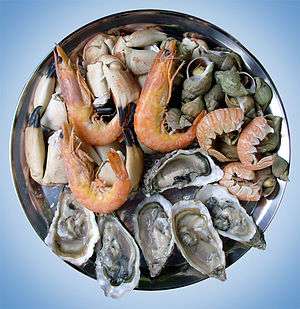Hoe (dish)
| Hoe | |
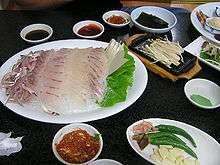 | |
| Korean name | |
|---|---|
| Hangul | 회 |
| Hanja | 膾 |
| Revised Romanization | hoe |
| McCune–Reischauer | hoe |
Hoe (Korean pronunciation: [ɸø] ~ [ɸe]) may refer to various raw food dishes in Korean cuisine. Saengseon hoe[1] (생선회) or "Hwareo hoe" (활어회) is thinly sliced raw fish or other raw seafood (similar to Japanese sashimi); yukhoe (육회) is hoe made with raw beef[2] and seasoned with soy sauce, sesame oil, and rice wine; and gan hoe (간회) is raw beef liver with a sauce of sesame oil and salt.
Saengseon hoe is also called sashimi (사시미) although It is unknown whether saengseon hoe is derived from sashimi. Despite the government's efforts to purify the Korean language, the term sashimi is still used in many restaurants.[3][4]
Fish hoe is usually dipped in a spicy gochujang-based sauce called chogochujang (초고추장) or Ssamjang (쌈장), and wrapped in lettuce and Korean perilla leaves.
When people finish a meal of saengseon hoe at a restaurant, they sometimes order maeuntang (spicy fish stew, from the fish heads and remaining meat) together with various vegetables.
History
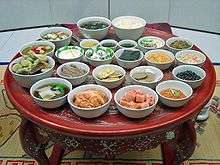 |
| This article is part of a series on |
| Korean cuisine 한국 요리 조선 료리 |
|---|
|
Staples |
|
|
It can be assumed that the tradition of eating hoe was introduced from China to Korea during the early Three Kingdoms Period (57 BC-668 AD), facilitated by frequent interchanges between China and the Korean peninsula. According to the Confucian Analects, written in the 1st century BC, Confucius said "Do not shun rice that is well clean; do not shun kuai that is thinly sliced" (食不厭精,膾不厭細).[5] While the term kuai (膾) originally referred to finely sliced raw fish or other meats such as beef or lamb, since the Qin and Han Dynasties it has referred mainly to raw fish. However, since Buddhism flourished in Korea from the middle part of the period until the late Goryeo Dynasty (918–1392), the killing of living beings was avoided, so that the habit of eating meat in general almost disappeared along with eating hoe. As the dominant influence of Buddhism fell off in the late Goryeo period, the consumption of hoe was revived. During the Joseon Dynasty, the state highly regarded Confucianism, and, as Confucius was known to have enjoyed eating raw meat, eating hoe was accepted without any resistance at that time.[6]
On the other hand, the consumption of raw meat or seafood is rare in present-day Chinese cuisine apart from in a few regions, such as the Chaozhou dish yusheng.
Gallery
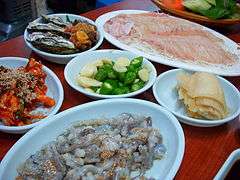 Various hoe
Various hoe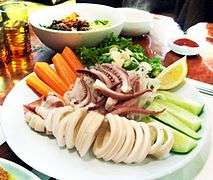 Ojing-eo sukhoe
Ojing-eo sukhoe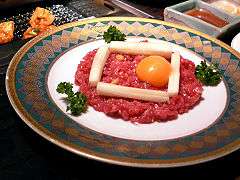
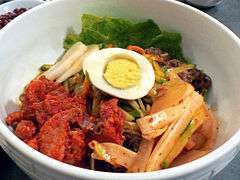 hoe naengmyeon, a variety of naengmyeon made with hoe
hoe naengmyeon, a variety of naengmyeon made with hoe
See also
References
- ↑ "LX F&B Akamatsu (아까마쯔)". Korea Tourism Organization. Retrieved 2013-04-05.
- ↑ "Yukhweh". South China Morning Post. 2012-08-15. Retrieved 5 April 2013.
- ↑ "Refined word (purified word) Sashimi[사시미]". Government and Media Loanword Joint Review Committee [정부.언론외래어심의공동위원회].
To be purified and standardized word: Sashimi [순화 및 표준화 대상어 사시미]
Purified and standardized word: Saengseonhoe (순화어 및 표준화 용어 생선회)
Original word: Sashimi (刺身)
Remarks (purified history): National Language purification information first collection(1977) Saengseonhoe (x: Use the purified word) [참고 사항(순화 이력 등) 국어순화자료 제1집(1977) - 생선회 (×: 순화한 용어만 쓸 것)] - ↑ "[우리말 바루기] '사시미'는 '생선회'로 [Sashimi as Saengseonhoe]". Joongang Ilbo. December 29, 2008.
- ↑ http://www.afpc.asso.fr/wengu/wg/wengu.php?no=248&l=Lunyu
- ↑ Kim Hak-min (김학민) (2003-07-16). 공자 사모님 힘드셨겠네 (in Korean). The Hankyoreh. Retrieved 2008-08-23.
External links
| Wikimedia Commons has media related to Hweh. |
